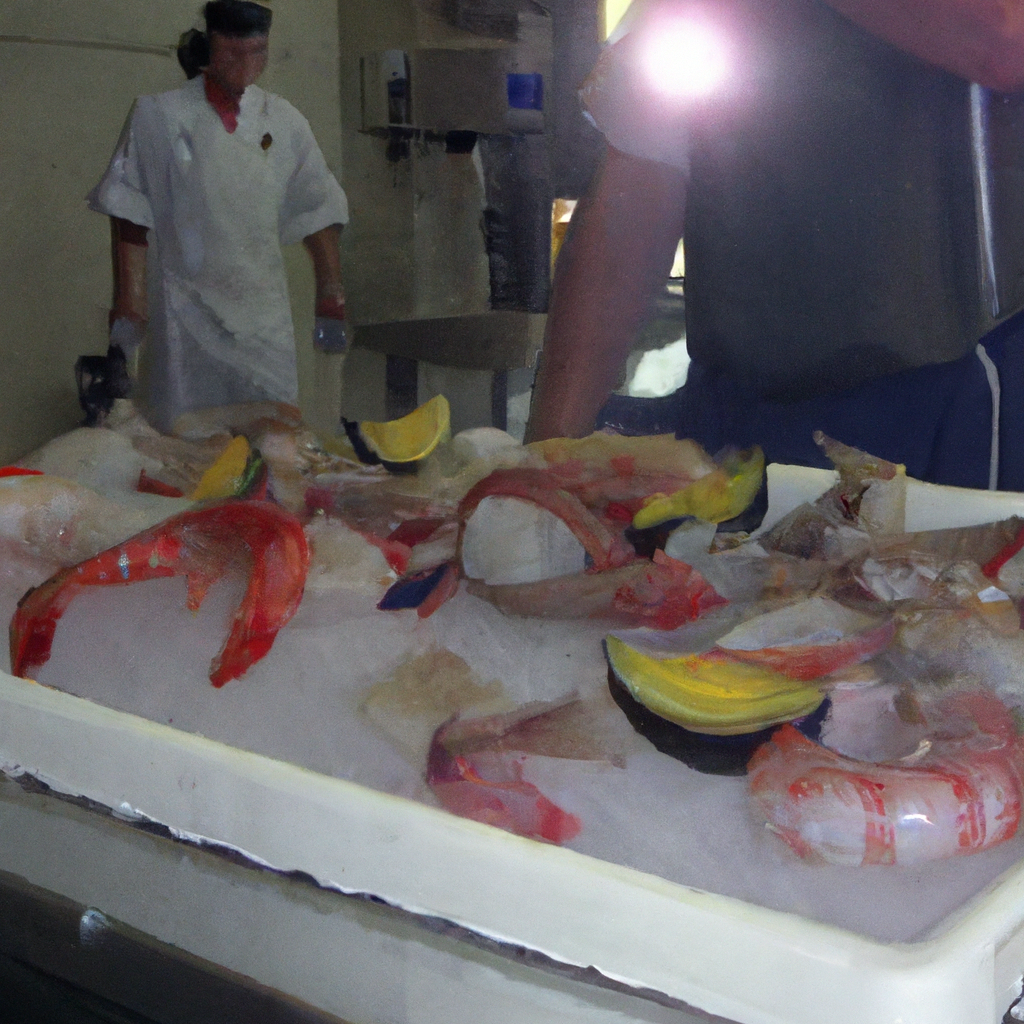Want to know how to make a positive impact on fish conservation? Look no further! In this article, we will explore the significance of sustainable seafood choices and their impact on the preservation of fish populations. By making conscious decisions about the seafood we consume, we can contribute to the protection of our oceans and ensure a sustainable future for both fish and humans alike. Discover the power of your meal choices and how they can make a real difference.

The Importance of Sustainable Seafood Choices
Preservation of Fish Species
When we make sustainable seafood choices, we contribute to the preservation of fish species. Overfishing is a significant threat to the abundance and diversity of marine life. By opting for sustainably sourced seafood, we can help maintain healthy fish populations and prevent species from becoming endangered or extinct. This is crucial not only for the ecological balance of our oceans but also for the long-term sustainability of fishing industries worldwide.
Protection of Ecosystems
Choosing sustainable seafood also plays a vital role in protecting ecosystems. Fish species often serve as key components of marine food chains, influencing the overall health and stability of their habitats. When one species is overfished or depleted, it can disrupt the delicate balance of an ecosystem and have far-reaching consequences. By consuming seafood from well-managed sources, we minimize the negative impact on ecosystems and help maintain their resilience.
Maintaining Biodiversity
Biodiversity is essential for the health and resilience of our oceans. Each species in the marine ecosystem has a unique role to play, contributing to the overall balance and productivity of the system. Sustainable seafood choices support biodiversity by promoting responsible fishing practices that target species in a way that allows for their natural reproduction and growth. By maintaining a diverse range of fish species, we ensure the long-term health and stability of marine ecosystems.
Understanding Sustainable Seafood Certification
Certification Programs
Sustainable seafood certification programs provide consumers with a reliable way to identify and choose seafood that is sourced and produced in an environmentally responsible manner. These programs, such as the Marine Stewardship Council (MSC) and the Aquaculture Stewardship Council (ASC), set specific criteria and standards that seafood producers must meet to receive certification. By looking for these certifications on seafood products, consumers can make informed decisions that support sustainable practices in the industry.
Criteria for Sustainable Seafood
Certification programs for sustainable seafood set specific criteria that encompass a range of factors. These include the health and abundance of fish populations, the impact on ecosystems and habitats, the use of fishing methods that minimize bycatch and habitat destruction, and the adherence to social and labor requirements. Meeting these criteria ensures that seafood is produced with minimal negative impact on the environment and the communities involved in the fishing process.
Benefits of Certification
Opting for certified sustainable seafood offers several benefits. Firstly, it provides consumers with assurance that the seafood they are purchasing has been sourced and produced responsibly. Certification programs also help drive positive change as companies strive to meet the certification criteria, improving their practices along the way. Additionally, certification labels on seafood products make it easier for consumers to identify sustainable options, simplifying the decision-making process.
Consumer Awareness and Empowerment
Educating Consumers on Sustainable Choices
Educating consumers about sustainable seafood choices is crucial for fostering positive change. Many people are unaware of the impact their seafood consumption can have on the environment and fish populations. By providing information on sustainable fishing practices, the importance of biodiversity, and the benefits of certification programs, consumers can make more informed decisions when purchasing seafood. This education can take the form of public awareness campaigns, school programs, and community engagement initiatives.
Labeling and Traceability
Accurate labeling and traceability systems are essential tools for empowering consumers to make sustainable seafood choices. Clear and transparent labeling allows consumers to identify certified sustainable seafood and make informed choices based on their values. Traceability systems also enable consumers to track the journey of their seafood, from the fishing vessel to their plate. This transparency builds trust and ensures that seafood is sourced legally and sustainably.
Consumer Decision-Making Process
Consumers play a vital role in driving the demand for sustainable seafood. By considering factors such as species health, fishing methods, and certifications, consumers can make conscious choices that support environmentally responsible practices. The decision-making process involves considering the environmental impact, ethical aspects, and personal preferences. Educating consumers and providing accessible information empowers them to make choices that align with their values and contribute to the conservation of fish species.
Economic Impact of Sustainable Seafood Choices
Market Demand and Pricing
Consumer demand for sustainable seafood has a significant impact on the market and pricing. As more individuals become aware of the importance of sustainable practices, the demand for certified sustainable seafood increases. This demand, in turn, drives the market towards more sustainable practices, encouraging fisheries and aquaculture operations to adopt responsible methods. As the market shifts towards sustainability, the pricing of sustainable seafood becomes more competitive, making it more accessible to a broader range of consumers.
Supporting Local Fishing Communities
Choosing sustainable seafood supports local fishing communities by ensuring long-term economic viability. By promoting sustainable practices, consumers contribute to maintaining healthy fish stocks and supporting the livelihoods of fishermen and coastal communities that rely on fishing. Sustainable fishing practices allow for the continued economic benefits of fishing, while also preserving the resources for future generations. Through their choices, consumers can play an active role in supporting the economic wellbeing of fishing communities.
Reducing Overfishing
Overfishing is a significant threat to fish populations and the economic sustainability of fishing industries. By opting for sustainable seafood choices, consumers contribute to the reduction of overfishing. Sustainable fishing practices focus on maintaining the health and abundance of fish populations, ensuring that they are not exploited beyond their capacity to replenish. This approach helps maintain a stable and sustainable market, benefiting both the industry and the long-term conservation of fish species.

The Role of Government and Policy
Fisheries Management and Regulations
Government agencies play a crucial role in the management and regulation of fisheries. Through policies and regulations, governments can enforce sustainable practices, set catch limits, and establish protected areas to safeguard fish populations and habitats. By implementing effective fisheries management strategies, governments can ensure the long-term sustainability of fish stocks and protect the livelihoods of fishermen. Collaboration between governments and stakeholders is essential to develop and enforce robust regulations.
Sustainable Fishing Practices
Government policies can incentivize sustainable fishing practices by providing support and incentives to fisheries that adopt responsible methods. These practices can include gear modifications to reduce bycatch, implementing catch limits and quotas, promoting selective fishing methods, and establishing marine protected areas. By promoting and supporting sustainable fishing practices, governments contribute significantly to the conservation of fish species and the overall health of marine ecosystems.
Collaboration and International Agreements
Collaboration between governments, international organizations, and stakeholders is crucial for addressing the global challenges of sustainable seafood choices. International agreements and partnerships can support the exchange of knowledge, best practices, and resources to ensure the responsible management of fish resources on a global scale. By working together, countries can harmonize regulations, share scientific data, and collectively tackle issues such as illegal, unreported, and unregulated fishing.
Technology and Innovation to Aid Fish Conservation
Fisheries Monitoring and Surveillance
Technology plays a vital role in monitoring and surveillance efforts to aid fish conservation. Satellite tracking, drones, and electronic monitoring systems can gather valuable data on fishing activities, including vessel movements and fishing gear used. This information helps authorities enforce regulations, assess the health of fish populations, and detect any illegal or unsustainable fishing practices. By embracing technological advancements, we can enhance our ability to protect fish species and maintain sustainable fishing practices.
Aquaculture Practices and Innovations
Aquaculture, or fish farming, is an increasingly important source of seafood. However, it also presents its own set of environmental challenges. Innovations in aquaculture practices, such as recirculating aquaculture systems and the use of sustainable feeds, can help minimize the negative impacts of fish farming on ecosystems. These practices focus on reducing water pollution, minimizing disease transmission, and improving the efficiency of resource utilization. By adopting sustainable aquaculture practices, we can support the conservation of wild fish populations while meeting the growing demand for seafood.
Sustainable Seafood Tracking Solutions
Traceability systems and seafood tracking technologies can help ensure the sustainability of seafood supply chains. By implementing these solutions, producers, retailers, and consumers can verify the origin and sustainability of seafood. These technologies include DNA barcoding, blockchain, and radio-frequency identification (RFID) tags, which enable the tracking of seafood from its source to the consumer. By increasing transparency and accountability in seafood supply chains, we can help combat illegal fishing and promote responsible practices.

Educational Initiatives for Sustainable Seafood Consumption
School Programs and Curriculums
Integrating sustainable seafood education into school programs and curriculums is crucial for fostering future generations of informed consumers. By teaching students about the importance of sustainable fishing practices, the impact of overfishing, and the benefits of biodiversity, we can raise awareness and empower young people to make sustainable choices. School programs can include field trips to fisheries and aquaculture facilities, interactive lessons on marine conservation, and discussions on the role of seafood in our diets.
Public Awareness Campaigns
Public awareness campaigns play a significant role in educating the general population about sustainable seafood choices. These campaigns can utilize various media channels, such as television, social media, and print advertisements, to raise awareness about the impacts of seafood consumption on fish populations and ecosystems. By providing clear and accessible information, these campaigns empower individuals to make environmentally responsible choices and actively participate in the conservation of fish species.
Community Engagement and Advocacy
Engaging local communities in the conversation about sustainable seafood consumption is essential for driving change at a grassroots level. Community engagement initiatives can involve public forums, workshops, and local events focused on sustainable fishing practices and the importance of supporting local fishing industries. By actively involving communities in the decision-making process and fostering dialogue, these initiatives promote a sense of ownership and encourage sustainable choices on a broader scale.
Challenges in Implementing Sustainable Seafood Choices
Shifting Consumer Attitudes and Behavior
One of the significant challenges in implementing sustainable seafood choices is shifting consumer attitudes and behavior. Many consumers are accustomed to making seafood choices based on taste, convenience, or price, without considering the environmental impact. Fostering a shift towards sustainable consumption requires raising awareness, providing accessible information, and highlighting the benefits of sustainable practices. Overcoming this challenge requires ongoing education and advocacy efforts to inspire individuals to prioritize sustainability when making seafood choices.
Lack of Uniform Standards and Certifications
The lack of uniform standards and certifications in the seafood industry poses a challenge for consumers seeking sustainable options. With numerous certification programs and labels, it can be confusing for consumers to determine which sources are truly sustainable. Harmonizing standards and developing a globally recognized certification system can help simplify the decision-making process for consumers and ensure that seafood products meet rigorous sustainability criteria. Collaboration between organizations and stakeholders is crucial to address this challenge and establish consistent guidelines.
Access and Affordability
Access to sustainable seafood and its affordability are challenges that impact the widespread adoption of sustainable seafood choices. In many regions, sustainable seafood options may be limited or more expensive compared to conventional choices. Addressing this challenge requires expanding the availability of sustainable seafood through increased production, improved distribution networks, and support for local fishing industries. Government support, incentives, and consumer demand can drive the market towards affordability and accessibility, making sustainable seafood choices more viable for all consumers.

Success Stories and Best Practices in Fish Conservation
Case Studies on Sustainable Fisheries
Numerous success stories and best practices in fish conservation provide inspiration and guidance for the sustainable seafood industry. Case studies highlight examples of fisheries that have successfully implemented responsible practices, such as reducing bycatch, improving gear selectivity, and protecting critical habitats. These success stories demonstrate that sustainable fishing is possible and economically viable, encouraging other fisheries to follow suit and contribute to the conservation of fish species.
Collaborations between Stakeholders
Collaborations between stakeholders play a crucial role in driving successful fish conservation initiatives. By bringing together government agencies, fishing communities, non-profit organizations, research institutions, and seafood retailers, stakeholders can pool resources, share knowledge, and develop innovative solutions. Collaborative efforts can enhance the efficacy of conservation measures, promote responsible fishing practices, and ensure the long-term sustainability of fish populations.
Innovative Conservation Initiatives
Innovation in the field of fish conservation has yielded promising results and presented new opportunities for sustainable seafood choices. Innovative initiatives include the establishment of marine protected areas, the use of artificial reefs to enhance fish habitats, and the development of new fishing technologies that minimize environmental impact. These initiatives demonstrate the power of innovation in driving positive change and present a path forward for more sustainable fishing practices.
Future Direction and Potential Solutions
Closing the Gap in Sustainable Seafood Supply
One of the future directions for sustainable seafood choices is closing the gap in the supply of sustainable seafood. This involves increasing the adoption of responsible fishing practices and promoting sustainable aquaculture methods. By expanding the availability of certified sustainable seafood, consumers will have more options to choose from, making it easier to prioritize sustainability. This can be achieved through targeted investments, research and development, and collaboration across the seafood industry.
Transparency in the Seafood Industry
Transparency in the seafood industry is a crucial aspect of promoting sustainable practices. Implementing traceability systems and ensuring accurate labeling enables consumers to make informed choices about the sustainability of their seafood. The industry can work towards standardizing traceability systems and adopting technologies that provide accurate information about the origin, fishing practices, and certifications of seafood products. Through increased transparency, consumers can have confidence in their choices and support the conservation of fish species.
Incorporating Sustainable Practices Globally
The future of sustainable seafood choices lies in the global adoption of responsible practices. While progress has been made in certain regions, there is still work to be done to ensure sustainability on a global scale. This includes supporting developing countries in implementing sustainable fishing practices, promoting responsible aquaculture expansion, and addressing the challenges of illegal fishing and seafood fraud. Global collaboration, knowledge sharing, and policy coordination are vital in achieving widespread adoption of sustainable practices and safeguarding the future of fish conservation.
In conclusion, sustainable seafood choices have a profound impact on fish conservation. By prioritizing responsible fishing practices, consumers can contribute to the preservation of fish species, protection of ecosystems, and maintenance of biodiversity. Sustainable seafood certification programs provide the necessary guidance and ensure that seafood is sourced and produced in an environmentally responsible manner. Educating consumers, improving labeling and traceability, and empowering individuals in their decision-making process are crucial for making sustainable choices. Economic impacts, government regulations, and technological advancements also play significant roles in ensuring the sustainability of seafood consumption. Overcoming challenges, learning from successful initiatives, and collectively working towards a future of sustainable seafood will ultimately lead us to a healthier and more resilient ocean ecosystem.


